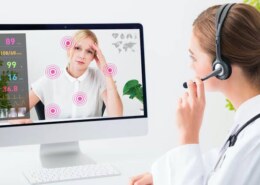Telemedicine has significantly transformed healthcare delivery, especially in remote areas, by leveraging technology to bridge geographical gaps and enhance access to medical services.
Telemedicine is the remote delivery of healthcare services using telecommunications technology. It allows healthcare professionals to evaluate, diagnose, and treat patients at a distance using various communication tools, such as video conferencing, phone calls, secure messaging, and other forms of digital communication. This approach enables patients to consult with healthcare providers remotely, overcoming geographical barriers and improving access to medical care, especially in areas where traditional in-person healthcare services might be limited or inaccessible. Telemedicine encompasses a wide range of medical services, including consultations, monitoring, follow-ups, and education, conducted through technological means.
Types Of Telemedicine
Telemedicine encompasses various types of healthcare services delivered remotely using technology.Each type of telemedicine offers unique advantages and is suited to different healthcare needs, contributing to improved access, convenience, and efficiency in delivering healthcare services remotely.Here are some common types of telemedicine:
Live Video Telemedicine (Synchronous):
This involves real-time interactions between patients and healthcare providers through video conferencing platforms. It allows for immediate consultations and diagnosis, similar to an in-person visit, but conducted remotely.
Store-and-Forward (Asynchronous):
In this type, patient health information, such as medical images, videos, or data, is collected and forwarded to healthcare providers at a different location or time for assessment. The healthcare provider reviews the information later and provides a diagnosis or treatment plan.
Remote Patient Monitoring:
This involves the use of various devices, such as wearables or sensors, to collect patient health data (e.g., vital signs, glucose levels) from a distance. This data is transmitted to healthcare providers for continuous monitoring and management of chronic conditions.
Mobile Health (mHealth):
It involves the use of mobile devices, such as smartphones or tablets, and healthcare-related apps for health monitoring, education, medication adherence, and communication with healthcare providers.
Teleconsultation and Telepsychiatry:
These are specialized forms of telemedicine focusing on remote consultations with specialists, including mental health professionals, providing diagnosis, counseling, and treatment remotely.
Telestroke Services:
Specifically designed for rapid assessment and treatment of stroke patients in remote locations, involving neurologists or stroke specialists who remotely assess and guide immediate treatment.
Impacts of Technology on Healthcare Delivery.
Increased Access:
Telemedicine enables patients in remote or underserved areas to consult with healthcare providers remotely, overcoming barriers related to distance and travel. Increased access in healthcare, facilitated by technology, refers to the expanded availability of medical services to individuals who might otherwise face barriers due to geographical location, physical limitations, or other constraints.
Cost Savings:
It reduces expenses associated with travel, accommodation, and time off work for both patients and healthcare providers.
Improved Outcomes:
Remote monitoring and consultations allow for timely intervention and continuous monitoring of chronic conditions, leading to better health outcomes.
Specialist Consultations:
Telemedicine connects patients with specialists who may not be physically present in remote areas, ensuring access to diverse expertise.
Emergency Care:
Telemedicine provides rapid access to emergency consultations and guidance, enabling timely response and potentially saving lives in remote locations with limited immediate medical assistance.
Health Education:
It facilitates the dissemination of health information and education, empowering individuals in remote areas to better manage their health.
Technological Advancements:
Advancements like wearables, AI-enabled diagnostics, and remote monitoring devices further enhance the effectiveness of remote healthcare delivery.
Enhanced Efficiency:
Electronic Health Records (EHRs) and Health Information Systems streamline administrative tasks, reduce paperwork, and facilitate better coordination among healthcare professionals, leading to more efficient healthcare delivery.
However, challenges such as infrastructure limitations, internet connectivity issues, regulatory concerns, and the need for training both healthcare providers and patients in using these technologies remain obstacles to widespread adoption and seamless implementation in remote areas.

